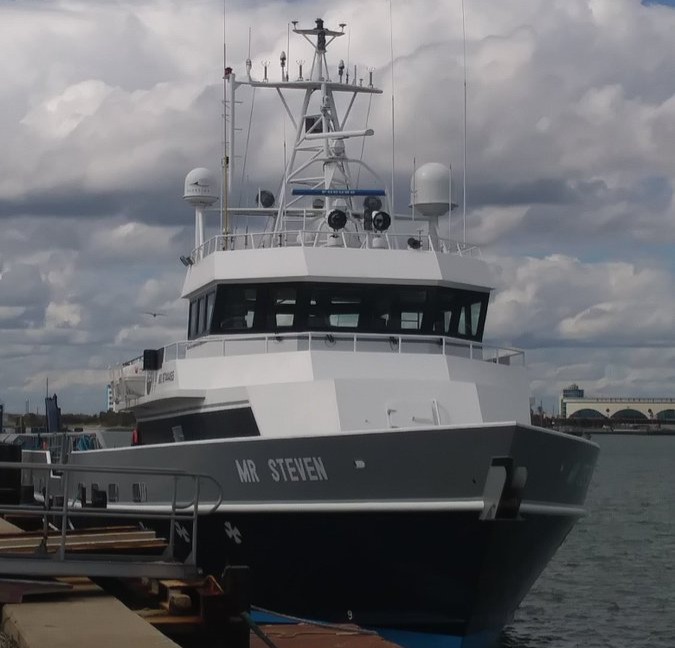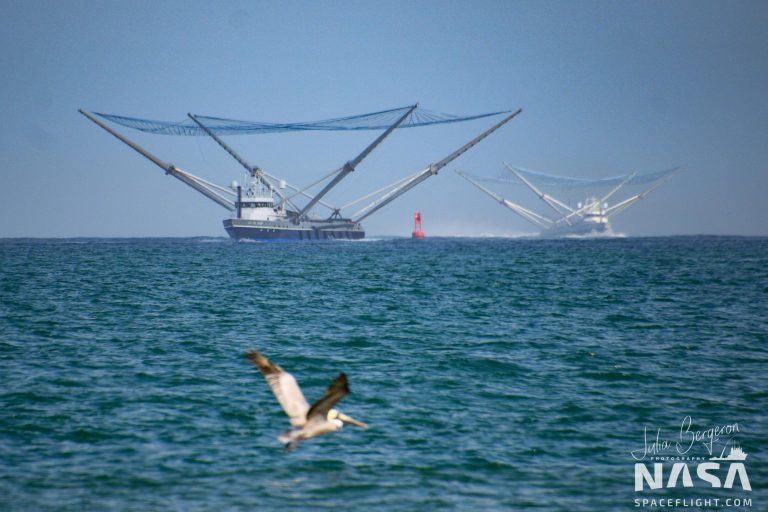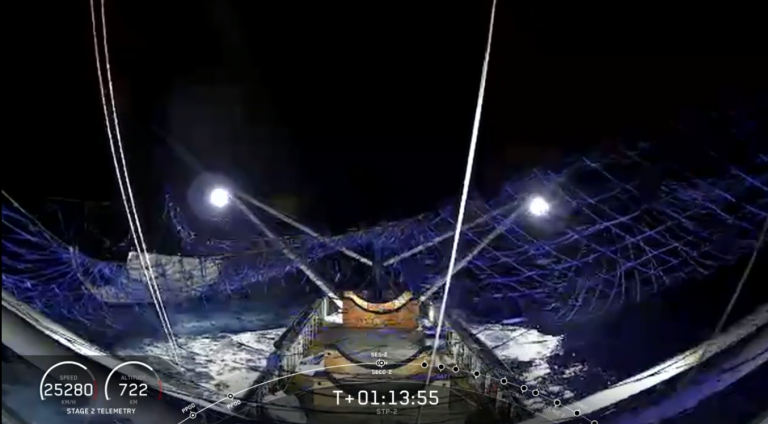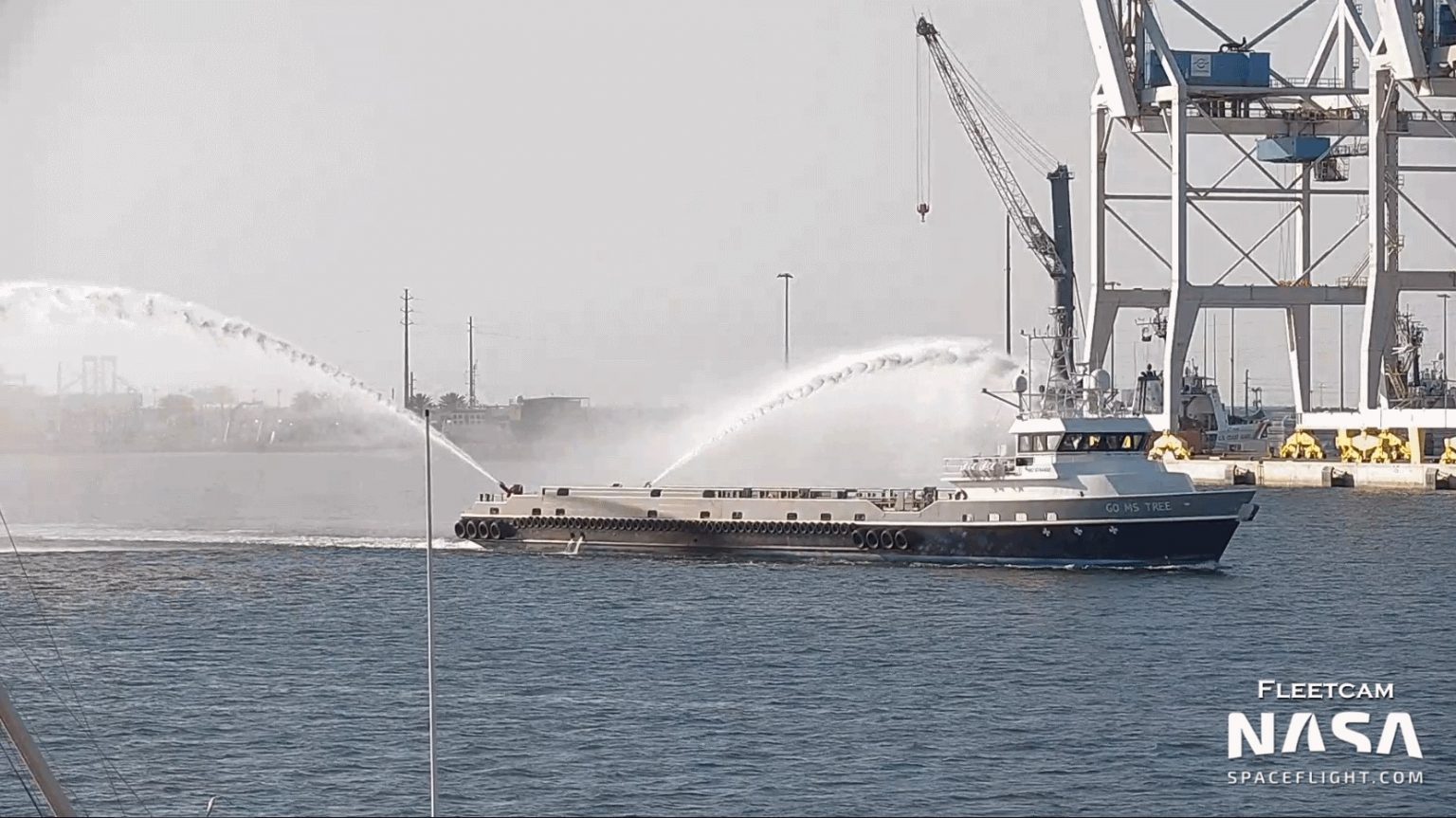SpaceX Fairing Recovery Program
SpaceX has been developing experimental techniques to recover payload fairings after launch since 2016. Payload fairings are designed to protect the launch vehicle payload from atmospheric pressure, acoustic effects, and aerodynamic heating during launch. Once free of Earth’s atmosphere these effects are no longer experienced so the fairing is jettisoned, splitting into 2 halves and falling back to Earth.
Each fairing half costs around $3 million dollars to manufacture and after jettisoning, it falls back to earth and is lost. Because of the manufacturing expense, SpaceX has experimented with ways to recover and re-use fairings to save money and bring down launch costs, just like they do with their Falcon 9 boosters.
The recovery method chosen by SpaceX was to equip fairings with thrusters and a steerable parafoil to control and slow the descent after jettison. Originally, SpaceX then planned to position a ship, equipped with a sizeable net, underneath the falling fairing to catch it before it hits the ocean surface. SpaceX attempted the fairing catch operation numerous times between 2018 and 2020 with mixed success. Owing to the lack of reliability, SpaceX had abandoned fairing catching by April 2021 and instead opted to allow halves to land gracefully on the ocean surface and then lift them from the water with a crane.
On early recovery attempts, SpaceX did not commit to using a ship to try and catch the fairing. To test, adapt and improve the parafoil guidance system, different ships were sent downrange to monitor the success of the procedure and then, if possible, haul the fairings from the water and bring them back to land for analysis. SpaceX started doing this in 2016 using a ship by the name of GO Searcher.
Initial attempts by GO Searcher did not prove very successful. It took 4 missions for the ship to manage to return anything to land. During the 4th attempt (SES-10) the ship recovered 2 sizeable chunks of fairing debris but nothing more, suggesting a failure with the parafoil or rapid destruction once the fairing was floating on the ocean surface.
In October 2017, a new ship named Ms. Tree (named Mr. Steven at the time) arrived at Port Canaveral, Florida. Ms. Tree was the ship that would ultimately be fitted with a net and attempt to catch the payload fairings. Before any modifications started, the ship was sent out during the KoreaSat-5A mission to perform GO Searcher’s role of observing the fairing’s descent and then recovering it from the water. The ship returned to Port Canaveral with a largely intact fairing half – the first major success of the program. Shortly after this, SpaceX moved Ms. Tree to California to develop the catching system closer to their Hawthorne headquarters.

Ms. Tree (as Mr. Steven) mission debut October 2017 – Julia Bergeron
With Ms. Tree now on the West Coast, and with GO Searcher now re-assigned to Crew Dragon recovery, a 3rd ship was needed to continue recovery operations on the east coast. GO Pursuit was brought in to perform the same role as GO Searcher once did. Throughout the first half of 2018, GO Pursuit was sent out four times, managing to recover two fairing halves.

Ms. Tree and Ms. Chief return from a mission – Julia Bergeron
Ms. Tree was first fitted with arms and a net in December 2017 in the Port of Los Angeles. Ms. Tree’s first attempt at catching a fairing half was during the PAZ mission in February 2018 but was unsuccessful. After little success, the vessel’s net and arm structure was significantly upgraded to be four times larger, totaling an estimated 3.600 square meters. Ms. Tree continued to make attempts at catching fairings throughout 2018 with no success. The ship was, however, frequently able to recover them from the water shortly after. For the full story of Ms. Tree’s mission history take a look at the dedicated page here.
In response to the catching attempt failure during the Iridium-5 mission, Elon Musk announced that helicopter drop-tests would be conducted to help improve the parafoil system and as practice for Ms. Tree’s crew. The announcement was made in March 2018. Ms. Tree conducted numerous tests between June and December 2018.
For the tests, a fairing half was placed onto a barge and towed out to sea. A helicopter would then pick up the fairing and ascend with it up to ~3.25km in altitude before dropping it. Ms. Tree, waiting below, would then follow the fairing and attempt to catch it as it descended downwards. Ms. Tree was reportedly not successful during any of the tests but came very close. SpaceX released two videos of the process on Twitter.
Recent fairing recovery test with Mr. Steven. So close! pic.twitter.com/DFSCfBnM0Y
— SpaceX (@SpaceX) January 8, 2019
One of Mr. Steven’s final West Coast fairing recovery tests before shipping out for the East Coast. Wait for it… pic.twitter.com/A7q37Gpllu
— SpaceX (@SpaceX) January 30, 2019

Ms. Tree’s first catch. The fairing half is the white object in the left side of the net.
Ms. Tree successfully caught a fairing half for the first time during the STP-2 mission on June 25th, 2019. The fairing recovery zone for the mission was at a record distance of 1,350 km downrange. The weather was excellent and the ship was successful in catching a fairing half for the first time. The fairing half was lowered from the net and delivered back to Port Canaveral for processing and potential re-use in the future.
Ms. Tree was again successful during the AMOS-17 mission on August 7th, 2019. The program has seen further success with the program since then but not consistently. SpaceX chartered a second fairing catcher vessel, Ms. Chief in August 2019 to allow SpaceX to catch both fairing halves during a single mission.
Ms. Tree and Ms. Chief were crewed at all times. During a catch attempt, the movements of the ship were directly controlled by a computer system; however, the crew could manually intervene if required. SpaceX slowly refined the system to improve the reliability of the catching operation. The descending fairing half and the ship computer communicated to autonomously steer themselves towards each other.
Recovery teams conducted a poll shortly before each catch attempt. During the poll, they reviewed the current weather and telemetry from the fairing to decide whether or not to proceed with a catch attempt.
If a catch had not been successful or SpaceX decided to not proceed with the attempt then the two ships had the ability to ‘scoop’ the fairing from the water. Each ship had a smaller scoop net underneath the catching net that could be lowered into the water. The fairing, which would be floating on the water, was then allowed to drift into the net which was then raised, lifting the fairing onboard.
Abandoning Fairing Catching
Throughout 2020, SpaceX was not always attempting to catch the fairing half and instead opting to go straight for wet recovery, a process where the fairing is allowed to gracefully land on the ocean surface and is then lifted onto the recovery ship by the crane of a recovery ship stationed nearby. This method often proved more reliable and less high-risk than catch attempts – which occasionally ended with significant damage to fairings and the catcher ships.
With a lack of catching reliability, SpaceX decided to abandon the catching program and opted to conduct wet recovery by default. GO Searcher and GO Navigator took on the responsibility of fairing recovery from March 2021 and Ms. Tree and Ms. Chief were slowly de-rigged of all SpaceX equipment – a process that took well over a month to complete. SpaceX had made significant upgrades to both ships, including the catching structure, computer systems, communications, and rigging
Ms. Tree officially retired from SpaceX recovery operations on April 6th, 2021. The crew of the vessel conducted a ceremonial water salute to spectators as they departed Port Canaveral for the very last time. Ms. Chief departed on April 12th, also with a water salute.

Ms. Tree retires from SpaceX operations with a ceremonial water salute – NASASpaceflight
New Ships
In September 2021, SpaceX debuted brand new dual-purpose support ships, Bob and Doug. Both ships perform multiple roles including droneship support and fairing recovery.
Bob and Doug are equipped with large cranes and deployable fast boats. Each ship can carry four fairing halves at a time. The ships lift the fairing halves from the water with a crane after they splash down under parafoil control.

Doug (left) and Bob (right) docked at Port Canaveral for unloading fairing halves – Jenny Hautmann
